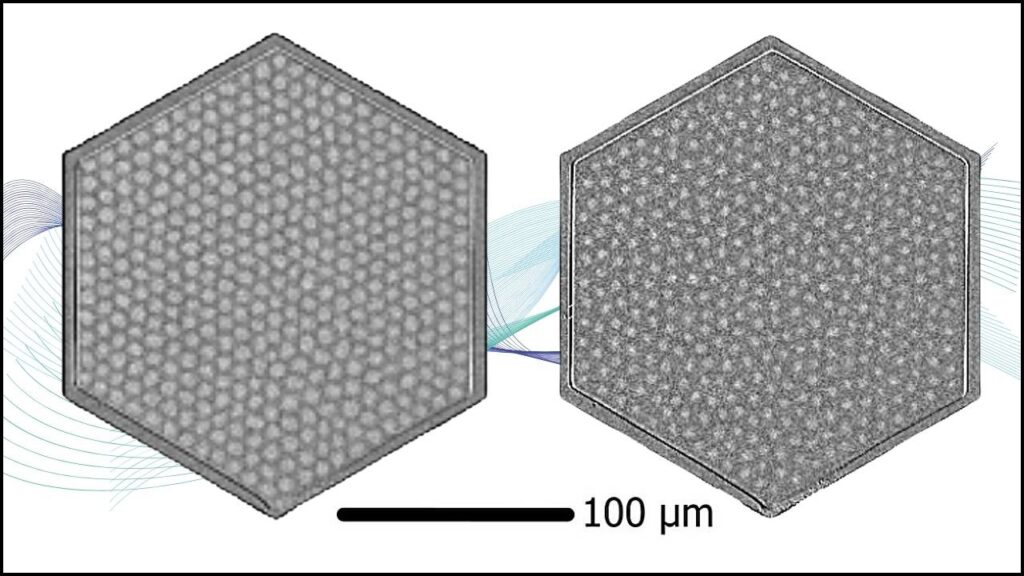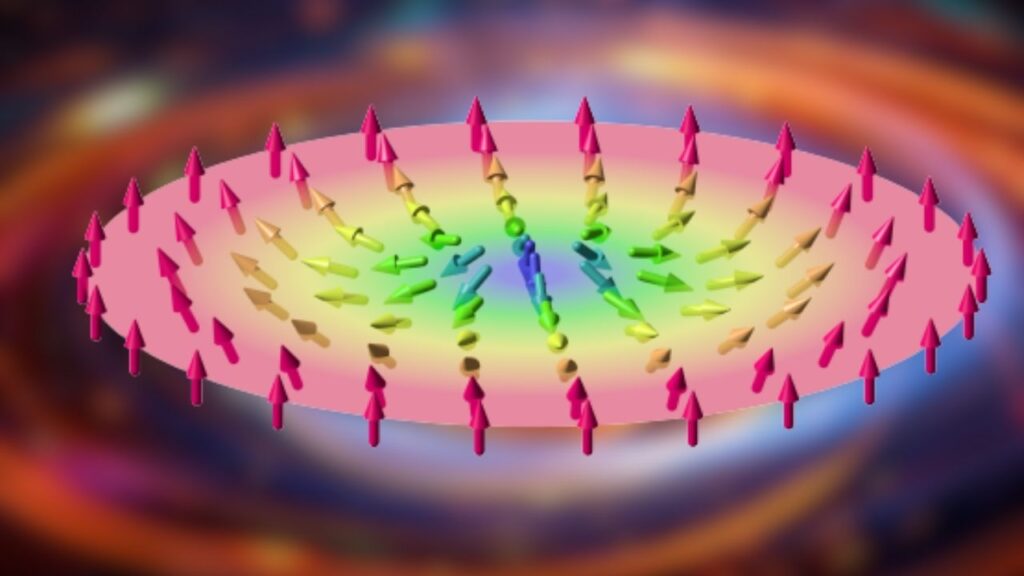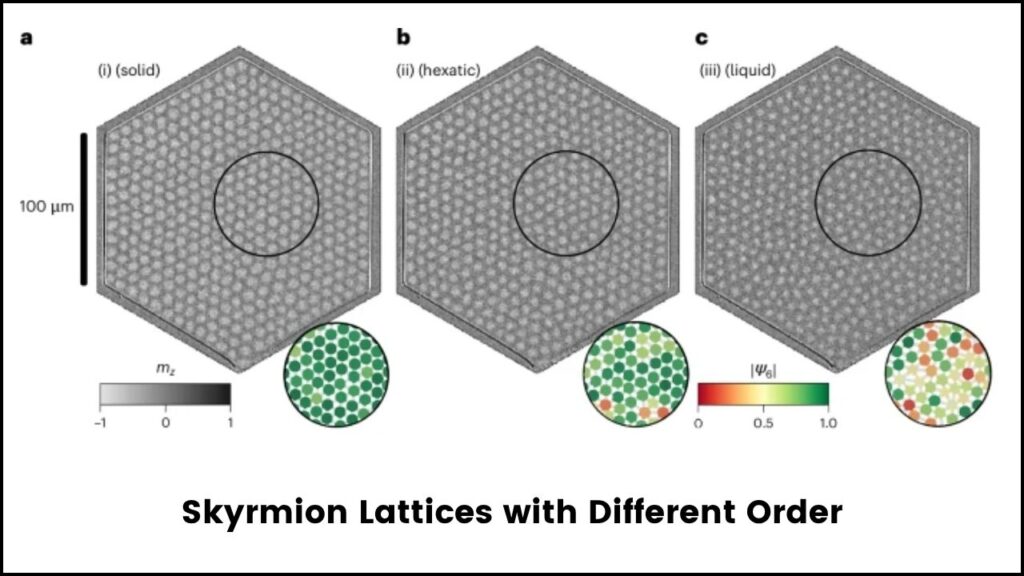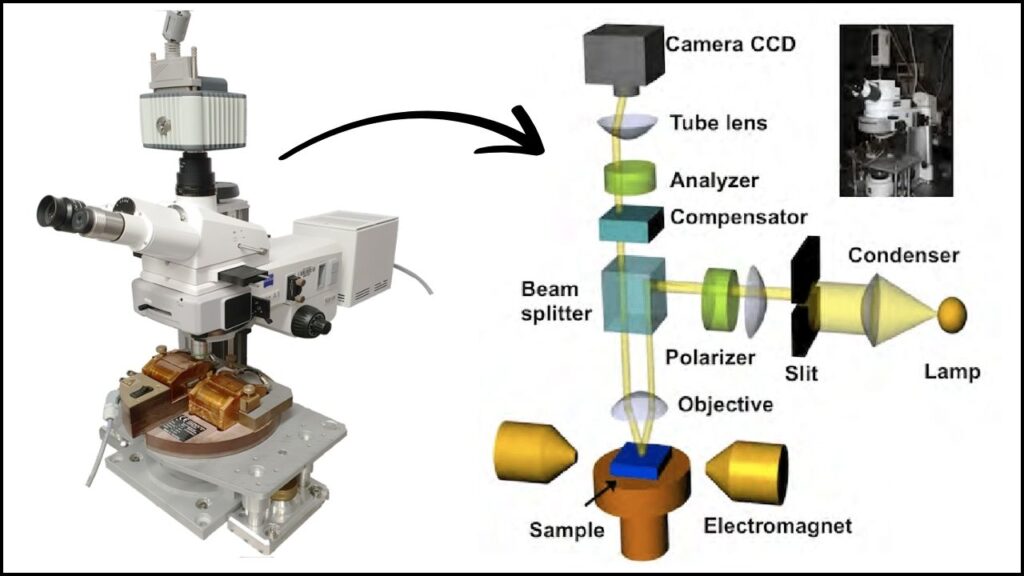In a pioneering scientific breakthrough, researchers have for the first time observed the melting of skyrmion lattices in real time. This breakthrough sheds light on a mysterious microscopic process with vast implications for the future of magnetic data storage and advanced materials science. The study offers a window into how tiny magnetic vortices—called skyrmions—organize and then dissolve in a manner distinct from everyday melting phenomena like ice turning to water.

Understanding skyrmion lattice melting is crucial, as these nanoscale whirls of magnetism hold promise for faster, smaller, and more energy-efficient memory devices. In this article, we dive deep into what skyrmions are, the significance of watching their lattices melt, how the research was conducted, and what it means for technology and science.
Table of Contents
Scientists Watch Skyrmion Lattices Melt in Real Time
| Highlight | Details |
|---|---|
| What is a Skyrmion? | A tiny, swirling magnetic vortex resembling a microscopic hurricane |
| Discovery | Real-time observation of 2D skyrmion lattice melting using magnetic field modulation |
| Melting Process | Occurs in two steps: loss of translational order, then loss of orientation, unique to 2D systems |
| Technique Used | Magneto-optical Kerr microscope to track skyrmion lattice dynamics |
| Practical Implication | Advances knowledge in phase transitions and aids development of spintronic devices and high-density data storage |
The real-time observation of skyrmion lattice melting is a landmark achievement in condensed matter physics and materials science. By revealing how these tiny magnetic whirlpools dissolve in two distinct steps, scientists have opened a new chapter in understanding magnetic phase transitions and paved the way for potentially revolutionary magnetic data storage technologies.
As researchers continue to refine techniques to control skyrmions and their lattices, the prospect of ultra-dense, energy-saving spintronic devices moves closer to reality. This work reflects the perfect blend of fundamental science and practical innovation, underpinning the technological advancements of tomorrow.
What Are Skyrmions and Why Do They Matter?
Skyrmions are tiny magnetic whirlpools, typically just a few nanometers wide (a nanometer is one billionth of a meter), acting like miniature hurricanes of magnetism. They form in certain magnetic materials when the spins of electrons swirl into stable, vortex-like configurations. Despite their small size, skyrmions are remarkably stable and can be moved with very little energy.

This stability and size make skyrmions excellent candidates for next-generation memory and computing devices, particularly in the field of spintronics—which exploits the electron spin rather than its charge. Skyrmions enable ultra-dense data storage and energy-efficient computing that could vastly outperform current technologies.
The Origins of Skyrmions in Physics
The concept of skyrmions was first introduced in the early 1960s by British physicist Tony Skyrme, who described them mathematically in a field theory context. However, it wasn’t until the 21st century that experimentalists discovered magnetic skyrmions in real materials, sparking a surge of interest.
Since then, scientists have uncovered fascinating properties such as their topological protection—meaning skyrmions are very difficult to destroy or alter without significant force, giving them potential advantages over other magnetic configurations.
The Science of Skyrmion Lattices
When many skyrmions group together, they tend to form lattice structures—regular patterns that resemble tiny crystals made of magnetic whirlpools. These lattices can be controlled by changing the temperature or applying magnetic fields.
The recent breakthrough involved carefully tuning the magnetic fields to manipulate the skyrmions, allowing scientists to watch how the lattice structure breaks down, or “melts,” in real time. Unlike traditional melting where heat disrupts atomic bonds (think of ice melting to water), skyrmion lattice melting is a two-step process unique to two-dimensional magnetic systems.
Two-Dimensional vs. Three-Dimensional Melting
In the everyday world, melting usually involves the transformation of a solid three-dimensional (3D) structure into a liquid. For example, ice melts into water when molecules gain enough energy to break their ordered bonds.
Skyrmion lattices exist primarily in two dimensions (thin films only a few atoms thick). Melting in 2D systems can be fundamentally different. Theories proposed decades ago suggested a multi-step melting process for 2D materials, but direct experimental confirmation had been elusive. This new observation confirms those theories in a magnetic system.
How Skyrmion Lattices Melt: A Two-Step Process

The melting of 2D skyrmion lattices unfolds in two distinct stages:
- Loss of Translational Order: At this initial stage, the skyrmions remain intact but the distances between them become irregular. Imagine a neat array of whirlpools starting to shift so they are no longer evenly spaced.
- Loss of Orientational Order: The second stage breaks down the lattice’s overall orientation, causing the skyrmions themselves to lose alignment, leading to complete disorder.
This nuanced process has been difficult to observe until now because of the speed and small scale at which it occurs.
How Did Scientists Capture This Phenomenon?
Researchers at Johannes Gutenberg University Mainz (JGU), led by physicist Raphael Gruber and Professor Mathias Kläui, used advanced techniques to witness skyrmion lattice melting directly.
- They employed a magneto-optical Kerr microscope, a powerful instrument capable of visualizing magnetic structures in thin films.

- Rather than simply heating the material (which might destroy skyrmions), they adjusted the magnetic field strength, causing the skyrmions to shrink and move more freely, mimicking the effect of temperature increase.
- This approach allowed the scientists to watch the exact stages of melting as they happened.
These results were published in the prestigious journal Nature Nanotechnology and represent a major step forward in understanding two-dimensional phase transitions.
Why Magnetic Fields Instead of Heat?
Heat can sometimes cause skyrmions to disappear entirely rather than just melt their lattice arrangement. Modulating the magnetic field offered a safer and more precise way of triggering melting by changing skyrmion size and mobility, allowing fine control over the process.
Practical Implications: From Theory to Technology
Skyrmions have already fascinated scientists for their potential in radically new computer memory designs. This breakthrough advances that mission by providing a clearer grasp of how skyrmion arrangements behave and change under different conditions.
- Data Storage: Skyrmion-based devices could store more data in a smaller space than current hard drives or solid-state drives.
- Energy Efficiency: Moving skyrmions requires less electric current, lowering power use dramatically.
- Spintronic Devices: These devices use electron spin states and could revolutionize logic operations and signal processing, crucial for future electronics.
Understanding how skyrmions melt and reorganize helps engineers design devices that are both stable and tunable for different applications.
Why This Matters to the Industry
In a world increasingly driven by data, demands for more compact, faster, and less power-hungry memory keep rising. Conventional silicon-based technologies are nearing physical and economic limits, prompting the search for alternative paradigms like skyrmion-based memories.
The ability to carefully control and understand the life cycle of skyrmion lattices—from formation through melting—helps propel these technologies beyond laboratory curiosities toward practical devices.
Leading tech companies and research labs worldwide are investing heavily in spintronics and skyrmions, seeing them as keys to the future of computing and information technology.
A Step-by-Step Guide to Understanding Skyrmion Lattice Melting
Step 1: Know the Basics of Magnetism
Electric charges have a property called spin which behaves like tiny magnets. When these spins align in certain patterns, they create various magnetic configurations.
Step 2: Understand Skyrmions as Magnetic Whirlpools
Think of skyrmions as tiny magnetic tornadoes forming in a sea of spins. They are stable configurations with a twist that protects them from simple disruption.
Step 3: Formation of a Skyrmion Lattice
When skyrmions gather, they arrange themselves in a pattern—a lattice—that acts like a magnetic crystal in two dimensions.
Step 4: Melting the Lattice
By changing a magnetic field, scientists observed that these lattices don’t melt like ice but undergo a two-step melting:
- First, the orderly spacing between skyrmions breaks down.
- Then, the orientation within the lattice becomes random, completely melting the structure.
Step 5: Real-Time Observation Techniques
The magneto-optical Kerr microscope detects subtle changes in the magnetic patterns, enabling real-time tracking of lattice melting.
Step 6: Implications for Future Tech
Knowing how to control and preserve skyrmion lattices can lead to breakthroughs in future magnetic memory and logic devices, making them faster, smaller, and more power-efficient.
MIT Just Found a Superconductor That’s Also Magnetic — Physics Textbooks May Need a Rewrite
Scientists Rewrite a Material’s Magnetic DNA Using Light: A Groundbreaking Leap in Material Science
Scientists Uncover Hidden Magnetic Structures Under Graphene With Supercharged Scanning Tech
FAQs About Scientists Watch Skyrmion Lattices Melt in Real Time
Q1: What makes skyrmions different from regular magnetic domains?
Skyrmions are topologically protected magnetic vortices, meaning they have a unique swirling pattern that is more stable and resistant to disturbances than typical magnetic domains.
Q2: Can skyrmions exist at room temperature?
Yes, recent research has shown that skyrmion lattices can be stable at or near room temperature in specially designed magnetic materials.
Q3: Why is watching skyrmion lattice melting important?
Observing this process in real time reveals fundamental physics behind phase transitions in 2D systems, crucial for advancing magnetic memory technologies.
Q4: How close are we to using skyrmion technology commercially?
While still mostly in the research phase, rapid advances suggest skyrmion-based devices could be commercially viable within the next decade.
Q5: How do skyrmion devices compare to current technologies?
Skyrmion-based devices promise much higher data density and lower power consumption than conventional silicon-based memory or magnetic storage.



















